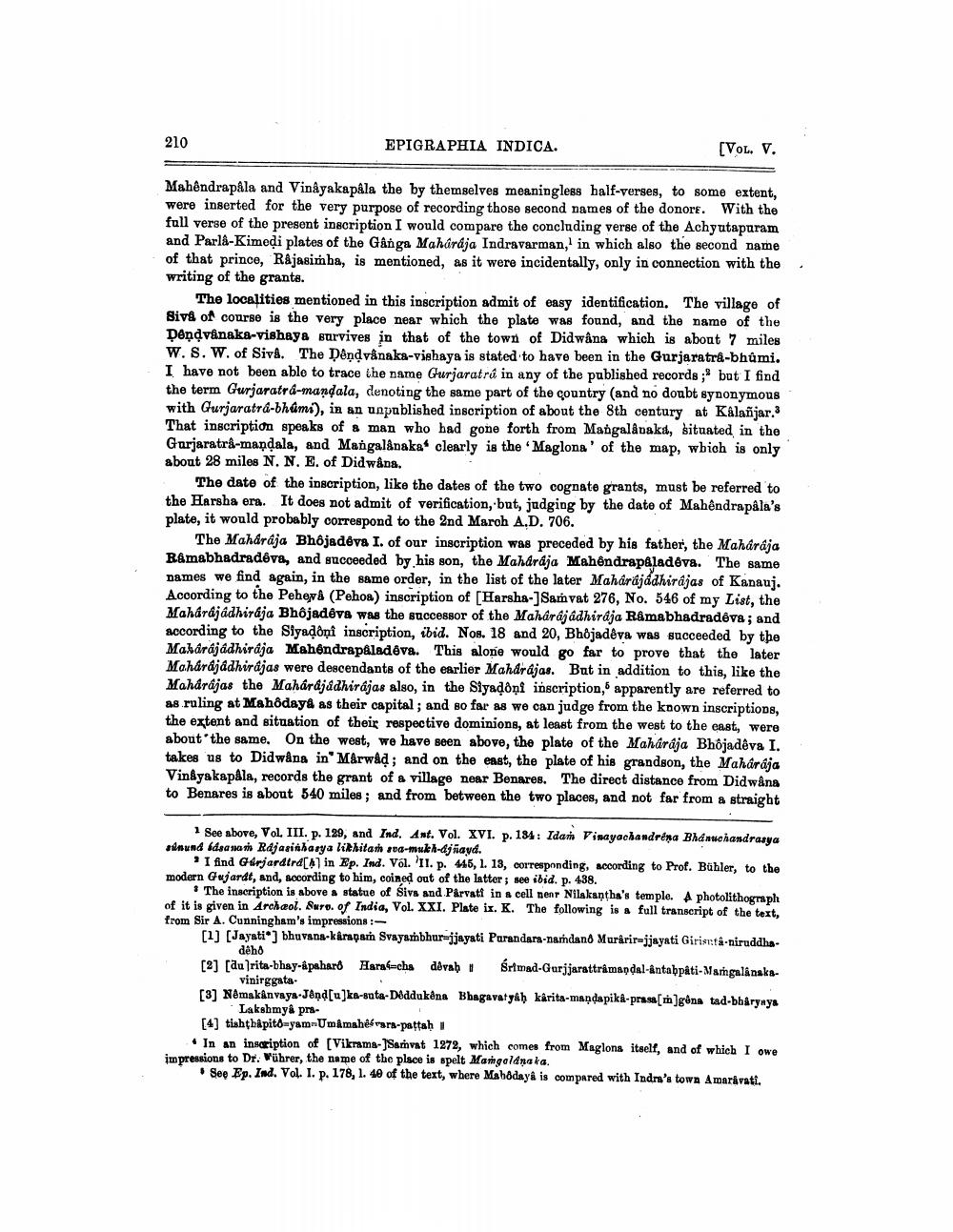________________
210
EPIGRAPHIA INDICA.
[VOL. V.
Mahendrapala and Vinayaka påla the by themselves meaningless half-verses, to some extent, were inserted for the very purpose of recording those second names of the donore. With the full verse of the present inscription I would compare the concluding verse of the Achyutaparam and Parla-Kimedi plates of the Gânga Maharaja Indravarman,' in which also the second name of that prince, Rajasimba, is mentioned, as it were incidentally, only in connection with the writing of the grants.
The localities mentioned in this inscription admit of easy identification. The village of Sive of course is the very place near which the plate was found, and the name of the Dåndvinaka-vishaya survives in that of the town of Didwana which is about 7 miles W. S. W. of Siva. The Dend vånaka-vishaya is stated to have been in the Gurjaratrå-bhúmi. I have not been able to trace the name Gurjaratrú in any of the published records ; but I find the term Gurjaratra-mandala, denoting the same part of the country (and no doubt synonymous with Gurjaratra-bhumi), in an unpublished inscription of about the 8th century at Kalañjar. That inscription speaks of a man who had gone forth from Mangalánaka, situated in the Gurjaratra-mandala, and Mangalánaka clearly is the Maglona' of the map, wbich is only about 28 miles N. N. E. of Didwana.
The date of the inscription, like the dates of the two cognato grants, must be referred to the Harsha era. It does not admit of verification, but, judging by the date of Mahendra påla's plate, it would probably correspond to the 2nd Maroh A.D. 706.
The Maharaja Bhôjadeva I. of our inscription was preceded by his father, the Maharaja Bâmabhadradêve, and succeeded by his son, the Maharaja Mahendrapkladêva. The same Dames we find again, in the same order, in the list of the later Maharajadhirajas of Kananj. Acoording to the Pehepa (Pehoa) inscription of (Harsha-] Samvat 276, No. 546 of my List, the Maharajadhiraja Bhojadeva was the successor of the Maharajadhirdja Råmabhadradova; and according to the Siyaddni inscription, ibid. Nos. 18 and 20, Bhöjadeva was succeeded by the Maharajadhiraja Mahendrapaladēva. This alone would go far to prove that the later Mohárajadhirajas were descendants of the earlier Maharajas. But in addition to this, like the Maharajas the Maharajadhirajas also, in the Siyadoņi inscription, apparently are referred to 88.ruling at Mahôdays as their capital ; and so far as we can judge from the known inscriptions, the extent and situation of their respective dominions, at least from the west to the east, were about the same. On the west, we have seen above, the plate of the Maharaja Bhojadeva I. takes us to Didwåna in Marwad; and on the east, the plate of his grandson, the Maharaja Vinayakap la, records the grant of a village near Benares. The direct distance from Didwana to Benares is about 540 miles; and from between the two places, and not far from a straight
1 See above, Vol. III. p. 129, and Ind. Ant. Vol. XVI. p. 184: Idara Vinayachandrēna Bharuchandrasya sinund Ideasa si Rajagisharya likhitan sua-mukh-djraya.
"I find Gárjardird[A) in Ep. Ind. Vol. 'Il. p. 445, 1. 13, corresponding, according to Prof. Bühler, to the modern Gujardt, and, according to him, coined out of the latter; see ibid. p. 438.
# The inscription is above a statue of Siva and Parvati in a cell nenr Nilskantha's temple. A photolithograph of it is given in Archaol. Suro. of India, Vol. XXI. Plate ix. K. The following is a full transcript of the text, from Sir A. Cunningham's impressions : (1) (Jayati*) bhuvana-karapam Svayambhurajjayati Parandara-nardand Murarirwijayati Giristá-niruddha
dého [2] [aulrita-bhay-ipharo Haras-cha dôvab śrtmad-Gurjjarattramandal-antabpâti-Mamgalánaka
vinirggata (3) Némskánvaya-Jánd[u]ka-sata-Deddukena Bhagavatykh kårita-maņdapika-prasa [min]gêna tad-bharynys
Lakshmyå prs[4] tishthäpito=yam-Umamahêsvara-pattah
In an inscription of (Vikrama-Samvat 1272, which comes from Maglons itself, and of which I owe impressions to Dr. Vührer, the name of the place is spelt Mangaldnaka.
• See Ep. Ind. Vol. I. p. 178, 1. 40 of the text, where Mahôdaya is compared with Indra's town Amaravati.




